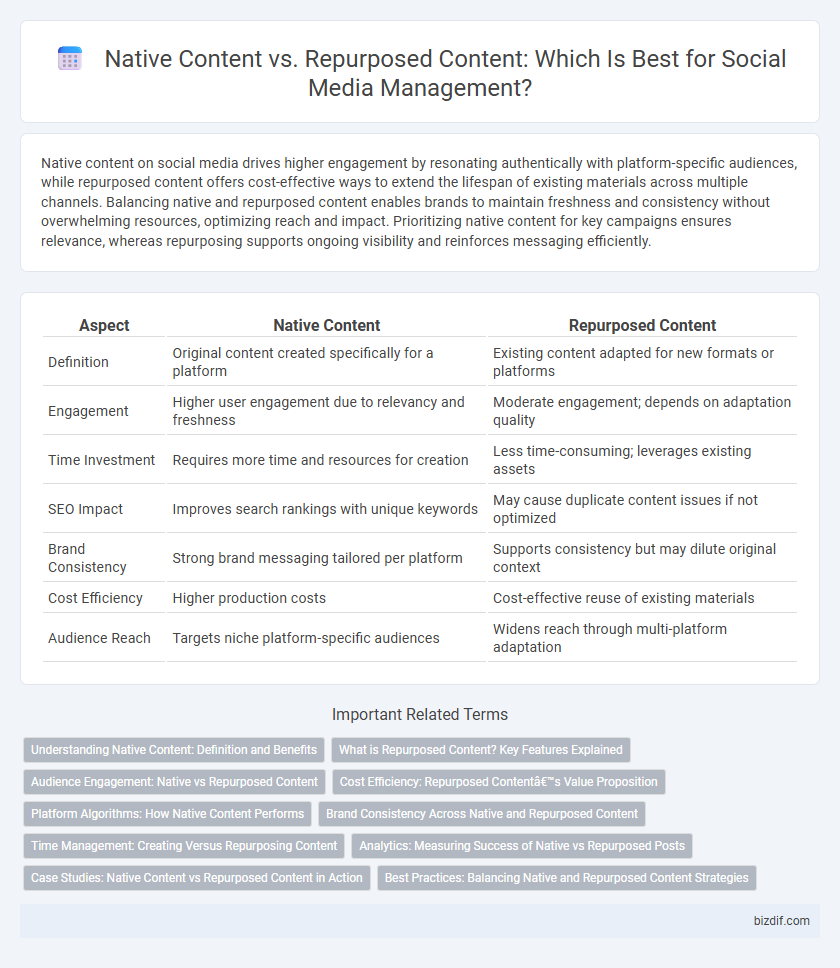Native content on social media drives higher engagement by resonating authentically with platform-specific audiences, while repurposed content offers cost-effective ways to extend the lifespan of existing materials across multiple channels. Balancing native and repurposed content enables brands to maintain freshness and consistency without overwhelming resources, optimizing reach and impact. Prioritizing native content for key campaigns ensures relevance, whereas repurposing supports ongoing visibility and reinforces messaging efficiently.
Table of Comparison
| Aspect | Native Content | Repurposed Content |
|---|---|---|
| Definition | Original content created specifically for a platform | Existing content adapted for new formats or platforms |
| Engagement | Higher user engagement due to relevancy and freshness | Moderate engagement; depends on adaptation quality |
| Time Investment | Requires more time and resources for creation | Less time-consuming; leverages existing assets |
| SEO Impact | Improves search rankings with unique keywords | May cause duplicate content issues if not optimized |
| Brand Consistency | Strong brand messaging tailored per platform | Supports consistency but may dilute original context |
| Cost Efficiency | Higher production costs | Cost-effective reuse of existing materials |
| Audience Reach | Targets niche platform-specific audiences | Widens reach through multi-platform adaptation |
Understanding Native Content: Definition and Benefits
Native content refers to original material created specifically for a social media platform, designed to blend seamlessly with the user experience and platform format. This type of content often generates higher engagement rates, as it aligns closely with audience expectations and platform algorithms. Brands leveraging native content benefit from enhanced authenticity, improved brand recognition, and increased visibility in organic reach.
What is Repurposed Content? Key Features Explained
Repurposed content refers to existing material transformed into new formats to maximize reach and engagement across different social media platforms. Key features include cost-efficiency, extended content lifespan, and diverse audience targeting by adapting blog posts into videos, infographics, or podcasts. This strategy enhances brand consistency while optimizing content performance and resource allocation.
Audience Engagement: Native vs Repurposed Content
Native content typically generates higher audience engagement by providing original, platform-specific messages that resonate directly with users' expectations and behaviors. Repurposed content, while cost-effective and time-saving, often experiences lower interaction rates because it may lack the tailored appeal or immediacy of native posts. Optimizing engagement requires balancing fresh, tailored native content with strategic repurposing that adapts existing materials to suit different social media formats and audiences.
Cost Efficiency: Repurposed Content’s Value Proposition
Repurposed content maximizes cost efficiency by extracting greater value from existing assets, reducing the need for continuous content creation expenses. Leveraging formats like videos, blogs, and infographics from a single piece minimizes production costs while maintaining audience engagement across multiple platforms. This strategic approach optimizes budget allocation, enabling social media managers to achieve broader reach without proportional increases in content development spending.
Platform Algorithms: How Native Content Performs
Native content aligns directly with platform algorithms by maximizing user engagement metrics such as likes, shares, and comments, which increases organic reach. Algorithms prioritize content that is original and tailored to the platform's format, enhancing visibility and interaction rates. Consistently published native content benefits from algorithmic favoritism, driving sustained audience growth and brand relevance.
Brand Consistency Across Native and Repurposed Content
Maintaining brand consistency across native and repurposed content is essential for reinforcing brand identity and trust on social media platforms. Native content delivers original, platform-specific messaging that aligns with audience expectations, while repurposed content allows for efficient reuse of high-performing materials adapted to different formats. Integrating cohesive visual elements, tone, and messaging ensures both content types support a unified brand presence and enhance engagement metrics.
Time Management: Creating Versus Repurposing Content
Creating native content demands significant time investment in ideation, production, and tailoring to each platform's unique audience preferences. Repurposing content efficiently leverages existing assets, cutting down content creation time by up to 60% while maintaining audience engagement through varied formats. Effective social media management balances original content development with strategic repurposing to optimize time management and ensure consistent brand presence.
Analytics: Measuring Success of Native vs Repurposed Posts
Analytics reveal that native content often achieves higher engagement rates and longer audience retention compared to repurposed posts, as it aligns closely with platform-specific algorithms and user expectations. Repurposed content can drive consistent impressions and extend content lifespan but may show lower interaction metrics due to reduced originality. Tracking metrics such as click-through rates, shares, and time-on-post is essential for evaluating the true impact of native versus repurposed social media content.
Case Studies: Native Content vs Repurposed Content in Action
Case studies reveal that native content generates 30% higher engagement rates compared to repurposed content due to its tailored relevance and platform-specific optimization. Brands focusing on native content report increased follower growth and stronger audience loyalty, while repurposed content serves effectively for reinforcing key messages across channels with reduced production costs. Analyzing performance metrics from top-performing campaigns highlights the importance of balancing fresh, original posts with strategically adapted repurposed content to maximize overall social media impact.
Best Practices: Balancing Native and Repurposed Content Strategies
Balancing native and repurposed content strategies involves leveraging the unique strengths of each approach to maximize engagement and reach. Native content, specifically crafted for each platform, enhances authenticity and user connection, while repurposed content efficiently extends the lifespan of high-performing posts by adapting them to different formats and channels. Implementing a strategic mix requires analyzing audience preferences and platform algorithms to maintain relevance, optimize resource allocation, and sustain consistent brand messaging across social media.
native content vs repurposed content Infographic

 bizdif.com
bizdif.com